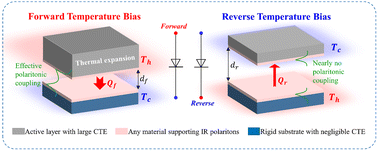Highly-efficient radiative thermal rectifiers based on near-field gap variations†
Abstract
Near-field radiative thermal rectifiers (NFRTRs) enabling directional heat transport hold great promise for various applications, including thermal logic computing, thermal management, and energy conversion. Current NFRTR designs rely on dissimilar terminal materials with high contrasts in their temperature-dependent dielectric properties, which in turn hinders the spectral match for radiative heat transfer and thus limits the device's efficiency. Herein, this dilemma is solved by designing heterostructures where a pair of polaritonic layers are separately stacked on a thermally-expanding layer and a rigid substrate, spaced by a vacuum gap. In this scheme, the symmetric polaritonic layers can provide stable near-field radiative channels for heat transfer, while the thermally-expanding layer can modulate the gap size with flipped temperature bias to allow high contrasts in heat flux. In exemplified implementations, the hBN-based design has achieved a record-high thermal rectification factor (TRF, ∼104) even under small thermal gradients (∼20 K), which can be further boosted by polaritonic hybridizations in the graphene/hBN-based design. This study paves the way to design novel NFRTRs with 2D materials, thus providing enriched polaritons to realize higher TRFs.

- This article is part of the themed collections: Nanoscale quantum technologies and Nanoscale 2023 Lunar New Year Collection


 Please wait while we load your content...
Please wait while we load your content...